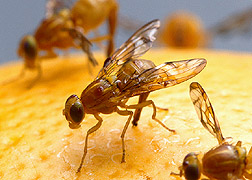This page has been archived and is being provided for reference purposes only. The page is no longer being updated, and therefore, links on the page may be invalid.
|
A Promising Lure May Curb South American Fruit Fly Woes
By Alfredo FloresNovember 21, 2005
Controlling damaging Anastrepha fruit flies in their country of origin before they enter the United States is the goal of cooperative research between the Agricultural Research Service (ARS) and ISCA Technologies, Inc., of Riverside, Calif.
Anastrepha fruit fly species are a serious pest in many regions, from northern South America to northern Mexico, penetrating into southern Texas. Anastrepha species have moved into California, Arizona and Florida, where growers are especially vulnerable to these flies, which infest citrus, including grapefruit and oranges, as well as pears, peaches and apples.
ARS entomologist David C. Robacker of the Crop Quality and Fruit Insects Research Unit in Weslaco, Texas, previously worked with a team of researchers from outside companies to develop an effective synthetic fruit fly lure. When tested on sticky bottle traps, this lure proved 20 times more effective than standard ammonium phosphate McPhail traps for capturing South American fruit flies (A. fraterculus). The lure remained effective for up to 16 weeks.
The lure shows great promise as a tool for detecting and monitoring Anastrepha species, according to Robacker. It could also be used for mass-trapping, or at bait stations or kill stations. Future research will determine if the lure will work in other geographical areas and for other species of fruit flies.
ISCA focuses on traps and lure-dispensing technologies and seeks new attractants that target important pests in both urban and agricultural settings. ISCA will continue to work with ARS to develop an effective and affordable lure and dispensing combination for this group of fruit flies, and will field test their formulations in Brazil.
The cooperative research and development agreement between ARS and ISCA allows for two years in which to jointly develop and market a successful Anastrepha lure in South America.
ARS is the U.S. Department of Agriculture's chief scientific research agency.

